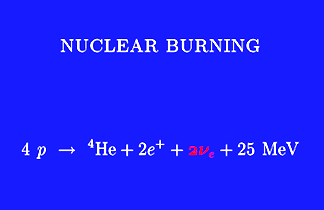
This viewgraph shows the energy budget for the generic set of nuclear
reactions that account for energy
generation among main sequence stars, the burning of four protons to
give an alpha particle, two positrons, and two neutrinos. The maximum
amount of energy the star receives as thermal energy is about 25
MeV. Neutrinos may take away a significant fraction of this energy.
A general introduction to the subject of solar neutrinos is given in ``Solar Neutrinos: Where We Are, Where We Are Going,'' ApJ 467, 475 (1996), hep-ph/9512285. The viewgraph above is equation (1) of this paper.
Color Viewgraph
Black and White Viewgraph
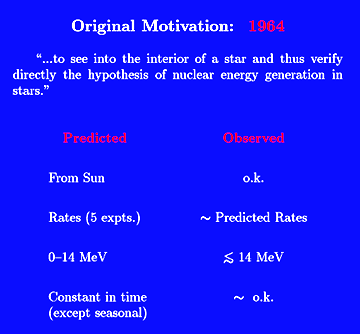 The quotation at the top of this viewgraph is the only motivation for
doing solar neutrino experiments that Ray Davis and I presented in our
back-to-back Phys. Rev. Lett. papers [Phys. Rev. Lett.
12, 300 (1964); Phys. Rev. Lett. 12, 303 (1964)]
in which we argued that a chlorine experiment was feasible and
desirable. It is ironic that solar neutrino experiments have generated
the most interest among physicists who want to test the properties of
neutrinos. This motivation was not considered by us in our original
papers and did not become a major impetus for doing solar neutrino
experiments until the ideas of solar neutrino oscillations, developed
by Pontecorvo, Gribov, Wolfenstein, Mikheyev, and Smirnov, became
popular. The astrophysical comparison between what was known in 1964
and what has been observed so far is based upon the discussion in:
``Solar Neutrinos: Where We Are, Where We Are Going,'' ApJ
467, 475 (1996), hep-ph/9512285.
The quotation at the top of this viewgraph is the only motivation for
doing solar neutrino experiments that Ray Davis and I presented in our
back-to-back Phys. Rev. Lett. papers [Phys. Rev. Lett.
12, 300 (1964); Phys. Rev. Lett. 12, 303 (1964)]
in which we argued that a chlorine experiment was feasible and
desirable. It is ironic that solar neutrino experiments have generated
the most interest among physicists who want to test the properties of
neutrinos. This motivation was not considered by us in our original
papers and did not become a major impetus for doing solar neutrino
experiments until the ideas of solar neutrino oscillations, developed
by Pontecorvo, Gribov, Wolfenstein, Mikheyev, and Smirnov, became
popular. The astrophysical comparison between what was known in 1964
and what has been observed so far is based upon the discussion in:
``Solar Neutrinos: Where We Are, Where We Are Going,'' ApJ
467, 475 (1996), hep-ph/9512285.
Color Viewgraph
Black and White Viewgraph
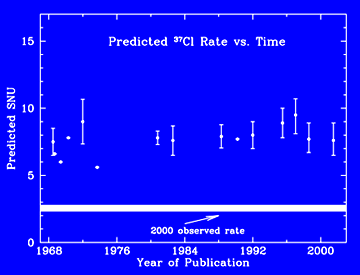
The
predictions of John Bahcall and his collaborators of neutrino capture
rates in the 37Cl experiment are shown as a function of the
date of publication.
The format is
from Figure 1.2 of
the book Neutrino Astrophysics by J. N. Bahcall (Cambridge
University Press 1989). I have updated the predictions through
2000.
Color Viewgraph
Black and White
Viewgraph
New Solar Neutrino Experiments
For two decades, 1967-1987, there was only one solar neutrino
experiment (the Homestake chlorine experiment of Ray Davis) and only
one ``solar neutrino problem'' (the discrepancy between Ray's
measurement and the predictions of standard solar models). In the
next decade, two additional pioneering neutrino detection
schemes were developed:
the Kamiokande water Cherenkov detector and the gallium radiochemical
detectors (GALLEX and SAGE). These detectors contributed two
additional `solar neutrino problems'' (see ``Solar Neutrinos: Where we
are'', astro-ph/9702057, or ``Solar Neutrinos: Where we are, Where we
are going'', Astrophysical Journal 467, 475, 1996, hep-ph/9512285).
Fortunately, there are now five new funded solar neutrino experiments
(Super-Kamiokande, SNO, GNO, BOREXINO, and ICARUS).
Although five may seem like a large number of new experiments, I am
very
concerned that we do not have sufficient redundancy to test
non-standard ideas in physics independent of the solar model
predictions. Redundancy is also essential to test whether
unrecognized systematic errors have crept into even the most
careful measurements. There is only one experiment that is planned to
measure the pure neutral current reaction (the SNO measurement of
deuteron disintegration, which will have some redundancy within SNO
itself)
and there is only one experiment (BOREXINO)
planned to
measure directly the crucial flux from the beryllium line (although
KamLAND also may ultimately be able to measure the beryllium line).
There are
no funded projects for measuring individual events from pp
neutrinos. although there are several very promising possibilities.
No experiments are planned
with sufficient precision to measure the 1.3 keV predicted shift
(relative to the laboratory value) of the average energy of the
beryllium neutrino line. This shift is a direct measure of the
central
temperature of the sun (see Phys. Rev. Lett. 71, 2369, 1993, hep-ph/9309292).
We need more experiments, especially experiments sensitive to
neutrinos with energies below 1 MeV and experiments sensitive to
neutral currents. My views on this subject are spelled out in "Why Do
Solar Neutrino Experiments Below 1 MeV," hep-ex/0106086.
New Solar Neutrino Experiments
This viewgraph is an updated version of Table 2 from the paper ``An
Introduction to
Solar Neutrino Research," in ``Physics of
Leptons,'' Proceedings of the
XXV SLAC Summer Institute on Particle
Physics. August 4-15, 1997,
SLAC R-528, ed. A. Breaux, J. Chan, L. DePorcel, and L. Dixon
(National Technical Information Service, U.S. Department of Commerce,
1998),
pp. 181-199, hep-ph/9711358.
Color
Viewgraph
Black
and White
Viewgraph
SNU
The solar neutrino unit, SNU, was introduced as a
pun that was snuck past the editor of Physical Review Letters by
defining it in footnote 10 of Phys. Rev. Lett. 23,
251 (1969). Here is the footnote: ``The symbol for this unit may be
pronounced euphonically as `snew' or read more formally as `solar
neutrino unit'.'' A SNU is a product of neutrino flux times neutrino
cross section, 10-36 interactions per target atom per
second, and is a convenient unit in which to quote the rates of
solar neutrino experiments.
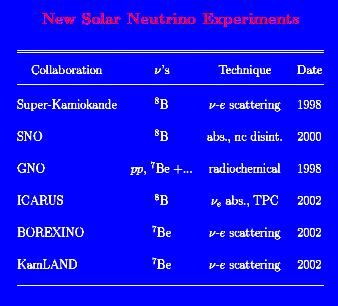
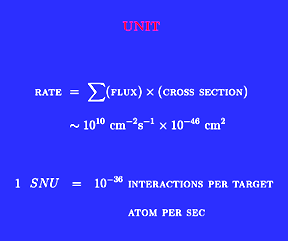
Color Viewgraph
Black and White Viewgraph
 Back to John Bahcall's Neutrino Viewgraphs
Back to John Bahcall's Neutrino Viewgraphs
Address questions and comments about this server to webmaster@sns.ias.edu